I’d recently mused about the alternatives to a Holga 135 series camera given the high cost. Just after that a newer color optical lens camera arrived and I managed to get a working 135BC.

But which camera rode high if any and which one ended sadly up in the Bin ?
Since Holga ceased production you can still get a 135 or 135BC new but you’ll need to pay ~£30 whether importing from HK or from UK reseller and I already mused on the alternatives. These included the color optical lens cameras which are not without their issues. A newer variant arrived in the shape of a 1990’s Roniflex X3000 and around this time I got a second working 135BC

The Holga 135BC shares a common chassis with most 135 series cameras and essentially is the same camera as the original 135 but with a mask to give classic holga Black corners (hence the BC). You get an all plastic body camera with 2 aperture setting and a fixed shutter speed (with a bulb option). The lens is marked as focus-able but most think that is more cosmetic. It does come with cable release.
Holga 135BC Specs
- Lens: Plastic 47mm
- Focus: 4 Zones
- Focal Range: 0.9m to ∞
- Metering: None
- Aperture: f/8 or f/11
- Shutter: 1/100 or Bulb
- EV (100ISO) : 13-14
- Filter: Push on
- Flash: Hotshoe
- Other: Tripod & Cable points
Looks like a 1970’s compact in black but as you’d expect from Holga was available in a range of often day glo colours. On it’s advantage is the Bulb mode and genuine cable point and the fact you can still buy a range of Holga accessories such as push on lenses and filters
In the challenger’s corner is the Roniflex. Don’t let the New Optical Lens moniker fool you – this is just another color optical lens camera. like my Barclaycard Visa one. That said quite nice looking in late 60’s silver black. It also doesn’t try too much to pretend to be something it isn’t unlike some of the sound-a-likes out there.
Roniflex X3000
- Lens: Plastic 50mm
- Focus: Fixed
- Metering: None
- Aperture: f/5.6, 8, 11 & 16
- Shutter: 1/100
- EV (100ISO) : 12-15
- Filter: Push on
- Flash: Hotshoe
- Other: Tripod
So the Roniflex loses focal options, bulb and cable but does add 4 aperture points. Those aperture points are shown in both numbers and weather symbols for 100 ISO. It also is in the collection of Museum of Design in Plastics (MoDiP) !
So How did they fare and how reliable are they?
In use both had their strong points. The Holga is smaller and it’ s viewfinder is much better. Although you’ll often see the camera as quoted as fixed focus there is a perceivable difference if you bother to use the 4 zones for focus (3,6,18 & 30+ft or ~1,2,6 & 10+ metres in new money). The switch gear for aperture and shutter are not as intuitive but match the Holga 120 series. The camera’s shutter is independent of winding and there is no Multiple exposure lock so multiple exposures are easy whether you want on not.


The Roniflex turned out to be no different on all levels than the barclaycard Visa Camera. Yes setting the aperture is more intuitive and you certainly get more options but the viewfinder is over magnified and truly rubbish and only serves to give a rough idea of the centre of a shot.

Okay shotwise the answer was clear. Whilst the Roniflex had better exposure range the lens was weaker and softer for outdoor shots. Unsurprisingly it had less vignetting than the 135BC .

The Holga optically is in a different class aided by the fact it is focusable. On target good central although things blur to the edge of frames. Optically this is the better camera. Unlike the Diana Mini it doesn’t try to ape the square frame format of it’s 120 parent.
Reliability is quite interesting. It took me 2 Holga 135BC to get a working one. That said both were second hand and really not much less than a new one with a warranty. Expect to pay £10-25 second hand and £25-30 for new. The second one works fine though
The Roniflex arrived for £4 plus postage and worked out of the box. But just like the Barclaycard Visa the rewind sprocket snapped so the camera is now no more. This genuinely seems an issue with these color optical lens cameras and although you can replace it (as I did with the barclaycard) the roniflex ended up binned.
The Holga (if working) is a better bet in the end and offers more options
Alternatives
- Diana Mini – another modern 35mm based on 120 classic
- VUWS & Clones – The Killer plastic lensed camera
- Halina 1000 – More reliable offering from 1970’s Haking
Helpful links
- Roniflex X3000 on Collection Appareils (French)
- Holga 135BC & TIM review at Geeky camera
- Holga 135BC v Diana Mini review at fortheeasilydistracted blog
- Holga Manual by Freestyle

I’ve used the 135BC, a bit too gimmicky – or at least hard to get acceptable results from for me. I have not used the Roniflex, but I do have a few “optical 50mm’s” – they are not all the same, but are a better alternative.
Most of the “50mm Optical lens” Taiwanese cameras come with instructions that tell you not to approach the subject closer than 2 metres. Why do ‘testers’ insist on photographing subjects at a lesser distance?
Totally agree re the 2m thing (that shot of the drain is from standing about a meter back so by my crap maths is around 2m away. They have a sweet focal spot around 3-4m IMHO which makes sense (many fixed focus cameras optimise for there as classic point for the group snapshot. Hyperfocal distance allows it to get away beyond.
I quite like shooting with color optical cams despite their quirks- my main issue is the brittleness